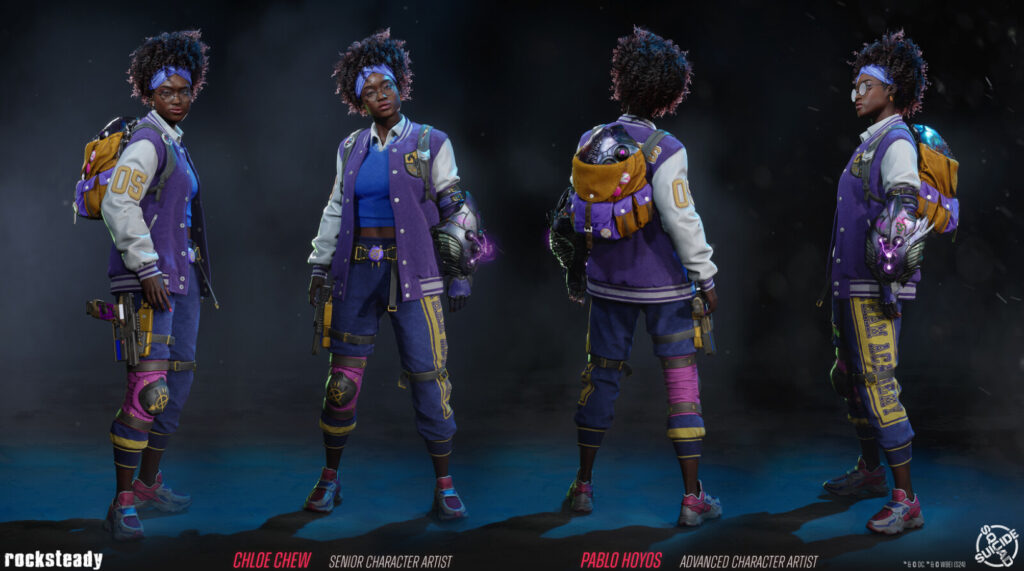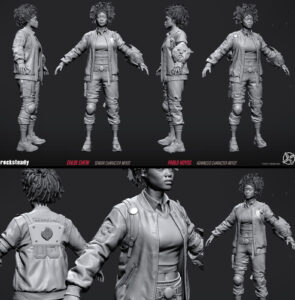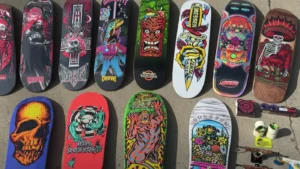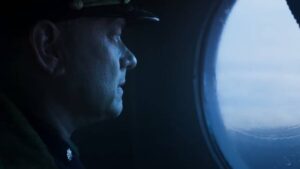When you’re building characters that belong in a world like Suicide Squad: Kill the Justice League, you’re not just dressing up pixels. You’re crafting personality through clothing. You’re embedding narrative into seams and straps. You’re balancing realism with chaos. And for Zoe Lawton’s classic look, that process was as tightly focused as it was creatively explosive.
This was a fast-paced, connective project where I was brought in specifically to work on core clothing assets for Zoe Lawton—a version of the character steeped in legacy, attitude, and tactical grit. My role encompassed high-poly modeling, texturing, and contributing partially to the in-game ready versions of her jacket, trousers, and backpack straps and accessories. The assignment may have been scoped, but the impact these elements had on her visual identity couldn’t be overstated.
What follows is a comprehensive look at the design process, artistic intent, and production techniques behind my contribution—alongside a celebration of the wider team’s collective artistry.
Understanding Zoe Lawton: The Character Behind the Fabric
Before diving into software or sculpting, I needed to grasp who Zoe Lawton is. She’s not just Deadshot’s daughter—she’s a complex figure carved out of legacy, rebellion, and purpose. Her classic iteration blends military precision with urban edge. That meant her wardrobe needed to hit a sweet spot: grounded but stylized, believable but not boring.
From a design standpoint, this translated into pieces that felt functional, worn-in, and personal. Her clothes aren’t pristine uniforms. They’re tools. They’re protection. They’re identity.
My job was to translate that character-driven intent into mesh and texture—anchoring realism in the details without overloading the silhouette.
High-Poly Modeling: Blocking Form and Character
Starting with high-poly sculpting, I tackled each piece—jacket, trousers, and backpack straps/accessories—as individual design problems nested within a larger character profile. Each item had to work on its own, and as part of a unified outfit.
The Jacket
Zoe’s jacket walks a line between tactical and casual. Structurally, it needed a defined silhouette—something that could support layers of detail (zippers, stitching, padding) without feeling cluttered or over-modeled.
I paid close attention to the sleeve construction and collar—those are the zones where attitude lives. We decided on subtle weathering, scuffs at the elbows, a folded collar with slight asymmetry, and cloth deformation that suggested both movement and age.
The Trousers
Utility ruled here. Pockets, seams, and stitching needed to not only look plausible, but intentional. These aren’t cargo pants for show—they’re built for function.
I added curvature to the fabric around the knees and hips to simulate wear patterns and ease of movement. The pocket placements were chosen to balance silhouette flow and suggest weight distribution—nothing should feel decorative; everything needed a reason.
Backpack Straps and Accessories
The backpack wasn’t my primary task—that honor went to Pawel Ptaszynski, whose craftsmanship deserves serious applause. My responsibility was supporting that piece through the strap work and associated gear. That meant attachment loops, harness details, modular rigging touches, and texture cohesion with Pawel’s pack.
Straps may seem minor, but they’re one of those “glue” elements that can make or break believability. I focused on buckles, stitching patterns, and cloth tension—how the weight of the pack affects how the straps sit on her shoulders, pull across the jacket, or shift with movement.
Texturing: Storytelling Through Wear and Tear
With the high-poly complete and feedback implemented, I moved into texturing, which is where the storytelling really kicks in. Texture isn’t just surface polish—it’s where you tell time. It’s where you mark use and history.
Materials
- Jacket: A heavy-duty cotton canvas blend—military-grade but softened with time.
- Trousers: Reinforced nylon mixed with canvas, giving a slightly synthetic edge.
- Straps: Worn ballistic nylon with embedded rubber and metal connectors.
Each texture was custom built in Substance Painter, with masks driving edge wear, oil marks, and grime buildup. I didn’t want “grunge for grunge’s sake,” though. Every stain, scrape, or discoloration had to mean something. Dirt near the cuffs? Ground contact. Scuffing on the thighs? Sliding into cover. Friction wear on the straps? Movement over time.
Color Pass
The palette had to complement the game’s mood: gritty, stylized realism with heightened contrast. Her jacket started in a classic military green but desaturated into a neutral olive tone—keeping her grounded in the team aesthetic while still giving room for unique flair through accessories.
The trousers followed suit with muted earth tones, allowing for shader-driven lighting effects to play a bigger role in-game.
From Sculpt to Engine: In-Game Model Contribution
Although my primary focus was modeling and texturing, I also supported some of the real-time model integration. That meant helping with mesh optimization and UV layout—ensuring my models didn’t just look great in ZBrush, but functioned in engine.
I handed off final textures and worked closely with the tech art team to keep visual fidelity high without blowing memory budgets. LOD considerations, clean topology, and balanced texel density were all part of the delivery process.
Collaboration: Shared Vision, Sharpened Craft
None of this happened in isolation. My work was part of a finely tuned pipeline, where each artist brought precision and perspective. It’s important to call out and celebrate their craft:
- Pablo Hoyos (Advanced Character Artist) built the rest of the outfit with masterful consistency. His eye for balance across character layers helped ground Zoe’s look in the world.
- Pawel Ptaszynski (Senior 3D Artist) delivered the backpack and gauntlet, both of which set the bar for material work and mesh precision. Pawel’s knack for micro-detailing ensured that even functional gear looked memorable.
- Little Red Zombies created the hair, bringing life and motion to Zoe’s head silhouette. Their strand work added a sense of realism that paired perfectly with the grit of the costume design.
Working with such a dialed-in team meant constant learning. Asset handoffs were smooth. Feedback loops were direct. And the synergy between departments made even a short-term collaboration like this feel cohesive and productive.
Final Thoughts: A Snapshot of Style and Substance
Zoe Lawton – Classic wasn’t just another character outfit. It was a case study in how to say more with less. By focusing on core clothing assets and letting every zipper, seam, and texture do narrative work, I was able to contribute meaningfully to a game that thrives on style, attitude, and immersion.
While my contributions were scoped to specific areas, I approached every inch of mesh and texture with purpose. In a character ensemble where every element matters, my goal was to make sure Zoe’s clothes didn’t just sit on her—they spoke for her.
And honestly? It was a blast. This kind of tight, focused collaboration is where I do my best work—driven by clarity, trust, and high standards.
Technical Breakdown
Tools Used:
- ZBrush (High-Poly Sculpting)
- Marvelous Designer (Initial Cloth Sim – modified post-sim)
- Maya (Retopo and UVs)
- Substance Painter (Texturing)
- Marmoset Toolbag (Bakes and quick lookdev)
- Unreal Engine (Final preview pass via dev environment)
Assets Contributed:
- Zoe Lawton Classic Outfit (partial)
- Jacket: Full asset (highpoly, textures, partial in-game mesh)
- Trousers: Full asset (highpoly, textures, partial in-game mesh)
- Backpack Accessories & Straps: Full asset
Pipeline Collaboration:
- In-house style guide compliance
- Texture/shader handoff
- Mesh optimization & LOD setup
- Version-controlled asset sharing (Perforce/Git-based)
Gallery
(Attach renders, texture maps, wireframe views, and breakdown GIFs here if this is going on ArtStation, a portfolio, or a studio deck.)
Would you like me to format this for ArtStation, LinkedIn, or another platform? I can also create shorter versions, image captions, or a technical shot list if you’re preparing a portfolio post.
No comments yet.









